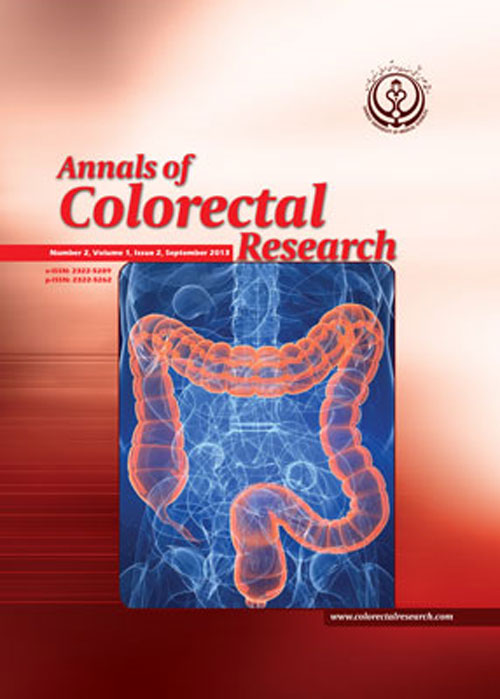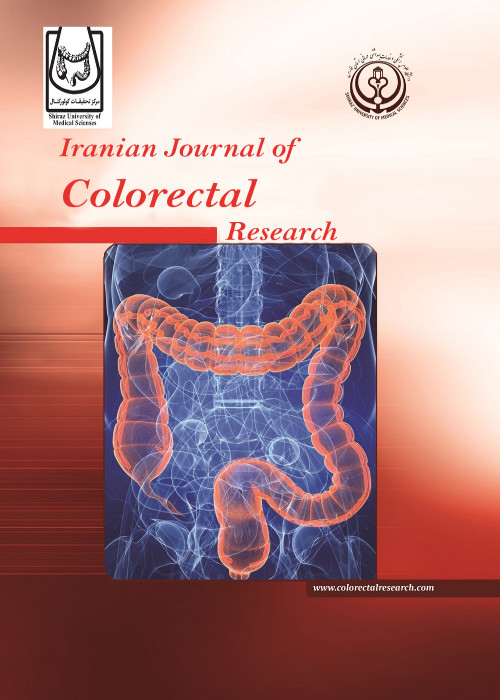فهرست مطالب

Iranian Journal of Colorectal Research
Volume:4 Issue: 3, Sep 2016
- تاریخ انتشار: 1395/08/15
- تعداد عناوین: 5
-
-
Page 1Context: The incidence of colorectal cancer has significantly increased in Iran during the last decade. Accumulating evidence suggests that there is a significant correlation between genetic variations such as polymorphisms and colorectal cancer. Therefore, identification of critical polymorphisms related to colorectal cancer can contribute to find individuals at high risk of CRC..
Evidence Acquisition: The focus of this review was on published articles in English about the association between different single nucleotide polymorphisms and colorectal cancer in the Iranian population. Evidences were gathered by searching online medical databases including Google scholar, Pubmed, Scopus and Science Direct..ConclusionsVarious single nucleotide polymorphisms of critical genes indicated significant association with colorectal cancer in the Iranian population. New polymorphism markers for high risk individuals have been recognized through further investigations to reduce the incidence and mortality of colorectal cancer..Keywords: Single Nucleotide Polymorphism, Colorectal Cancer, Iranian Population -
Page 2BackgroundRectal resection for cancer can be technically challenging, especially in the obese patient. While some have investigated the impact of laparoscopic surgery on rectal cancer, no study looked at the subgroup of morbidly obese patients..ObjectivesOur goal was to evaluate feasibility and safety of laparoscopic rectal resection for cancer in this population..MethodsAll morbidly obese patients, defined as a body mass index (BMI) of 40 kg/m2 or greater, undergoing laparoscopic rectal cancer resection for primary cancer between January 2006 and July 2013, were identified using medical records in a single academic hospital center..ResultsThirteen patients underwent laparoscopic approach. The median BMI was 42.4 kg/m2. There were 4 conversions (30%). Anastomotic leak occurred in 2 patients (15.4%). TME was complete in only 9 patients (69.2%), with 3 patients with incomplete TME being also in the conversion group. There was no mortality. There was no recurrence..ConclusionsThis study suggests that laparoscopic rectal resection for cancer in morbidly obese patients is challenging and associated with a higher rate of conversion compared to patients with lower BMI. Mortality, morbidity and readmission rates are similar to the literature showing the same benefit for laparoscopic procedure..Keywords: Rectal Cancer, Mordid Obesity, Laparoscopic Surgery
-
Page 3BackgroundAcute colonic diverticulitis is generally considered to be a clinical diagnosis, however the use of CT (computed tomography) imaging in diverticulitis is becoming more common to exclude complicated diverticulitis..ObjectivesTo assess the use of CT imaging in the acute presentation of suspected colonic diverticulitis and whether clinical management was altered depending on imaging findings..MethodsRetrospective audit of all patients admitted to Flinders Medical Centre with a clinical diagnosis of acute colonic diverticulitis in ED or following investigation with CT between July 2011 and February 2012..ResultsA total of 79 patients were suspected of having diverticulitis. 57 (72.2%) patients were confirmed to have diverticulitis following imaging of which 46 (80.7%) patients had simple diverticulitis and 11 (19.3%) patients had complicated diverticulitis (perforation n = 7 [12.3%]; abscess n = 4 [7.0%]). Overall only 6.3% of patients required radiological or surgical management for their presentation..ConclusionsThere is an overuse of CT in the investigation of acute diverticulitis with limited change in clinical management as only 6.3% of patients required surgical or radiological intervention. We suggest medical management with intravenous antibiotics and bowel rest with imaging indicated after 72 hours if no clinical improvement (or earlier if warranted by the clinical status)..Keywords: Colonic, Computed Tomography, Diverticulitis, Imaging, Laparotomy
-
Page 4Surgical treatment of high perianal fistulas, which affect a significant proportion of the sphincter apparatus, is difficult and associated with considerable risk of impaired anal continence. The diversity of approaches proposed for the treatment of complex perianal fistulas reflects the fact that no method has yet been shown to be fully satisfactory. We believe the successful treatment of this condition is directly proportional to the amount of fibrous tissue that can be removed. We used a kit of small curettes, of different thicknesses and sizes, incorporating spicules that enable the physician to remove fibrous tissue from the fistula tract. The small size and varying thicknesses of the curettes enable them to mold to the curves of the fistula tract and to remove tissue by de-roofing from the shallowest to the deepest layers, thus excising the entire fibrous tract. The tract is then sealed using autologous fibrin, applied through a catheter, with the help of a monitor indicating the amount of product remaining at all times. Finally, the internal orifice is closed by simple suturing..Keywords: Anal Fistula, Sealant, Curettage, Platelet Rich Fibrin
-
Page 5Giant condyloma acuminatum (GCA) commonly known as Buschke-Lowenstein tumor (BLT) is a rare sexually transmitted disease, which is always preceded by condyloma accuminata and linked to human papillomavirus (HPV). Most commonly affected sites are male and female genitalia, anal and perianal regions. Giant condyloma acuminatum is well-known as slow growing but locally destructive with a high rate of recurrence and increased frequency of malignant transformation. Surgical management is considered to be the best among all the options..Keywords: Buschke, Lowenstein Tumor, Giant Condyloma Acuminatum


